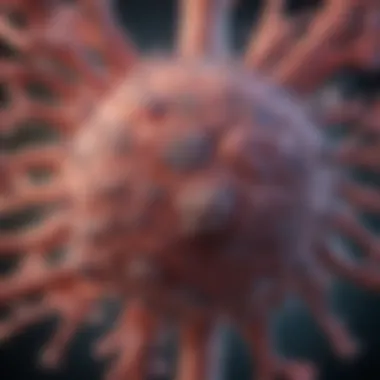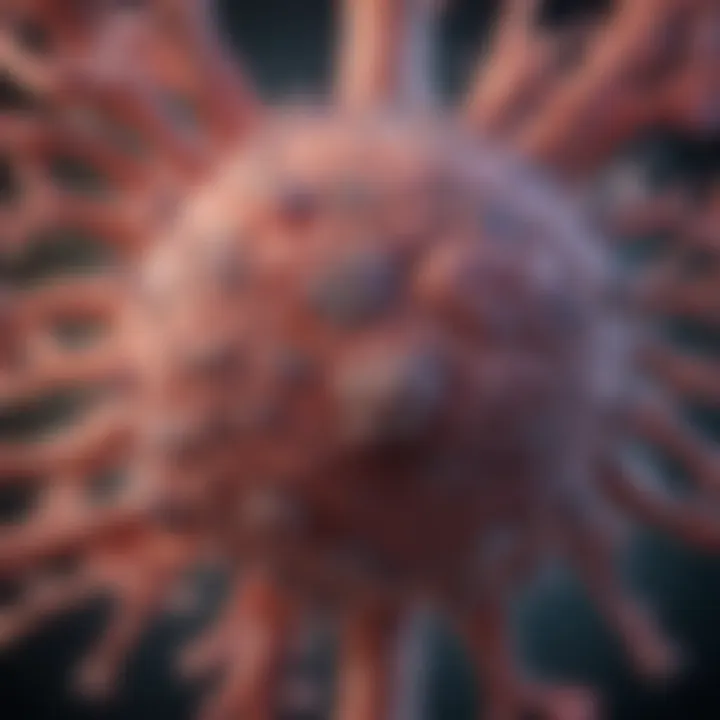Exploring the Complexities of Lung Cancer Relapse


Intro
Lung cancer relapse is an intricate and multifaceted issue that poses significant challenges for both patients and healthcare professionals. The recurrence of lung cancer after initial treatment can be a startling and disheartening reality for those affected. Understanding the underlying mechanisms of this phenomenon is crucial in both improving treatment outcomes and providing support for patients as they navigate the complexities of their illness.
The mechanisms behind lung cancer relapse stem from a variety of biological, environmental, and psychological factors. By diving deep into these influences, we can unravel the web of interactions that contribute to this serious condition. Furthermore, the implications of these relapses extend beyond mere medical concerns, affecting patients’ psychological well-being and social dynamics.
In this article, we aim to articulate a comprehensive narrative that outlines the critical aspects of lung cancer relapse, focusing on the biological underpinnings, risk factors, and the broader implications on patient care. Our analysis will serve to inform healthcare professionals, researchers, and those living with lung cancer about the nuances of this challenging issue, aiming to enhance awareness and foster advancements in patient management.
Intro to Lung Cancer Relapse
Lung cancer relapse is a pressing concern within the field of oncology. After undergoing treatment, many patients experience a resurgence of cancer, which can cast a long shadow over their recovery journey. Understanding the nuances of this recurrence is critical not only for medical practitioners but also for patients and their families. Accepting the fact that relapse can occur often instills a sense of urgency in developing strategies aimed at mitigating this risk.
What makes lung cancer relapse particularly complex is its multifaceted nature. It encompasses a range of biological mechanisms, patient-specific factors, and external influences. By examining these elements closely, this article shines a light on both the concerns surrounding lung cancer relapse and the potential avenues to address it. The wealth of information presented aims to empower healthcare professionals and patients alike, enabling them to make informed decisions regarding treatment and follow-up care.
Integrating recent statistics and ongoing research findings into our understanding, we can appreciate how prevalent this issue is and how it shapes the course of care for lung cancer survivors. For example, the evolution of therapeutic options continues, acting as a double-edged sword; with advancements in treatment come new challenges in monitoring for relapse.
Defining Lung Cancer Relapse
The term 'lung cancer relapse' refers to the return of cancer after a period of improvement or stability following initial treatment. This condition is not merely a medical term; it carries profound implications for the affected individuals and their families. While initially, a patient may seem to be on the mend, the lurking potential for relapse raises questions about the efficacy of treatment approaches and the biological traits of the cancer cells previously removed or targeted.
Defining the technicalities of lung cancer relapse goes beyond survival statistics; it's a dialogue about the ongoing battle against a cunning adversary. Furthermore, the emotional toll of relapse can be just as significant as the medical ramifications. Knowing that cancer might not just come back but might do so aggressively affects how one approaches the entire treatment process and ongoing surveillance.
Prevalence and Statistics
When discussing lung cancer relapse, one can hardly overlook the data that informs our understanding of its prevalence. Studies indicate that approximately 40 to 70 percent of patients diagnosed with lung cancer experience relapse after achieving initial remission. These statistics shake the foundation of what patients and healthcare providers often consider a successful outcome.
- Non-Small Cell Lung Cancer (NSCLC): A predominant type where relapse rates tend to be higher due to factors like genetic mutations or incomplete response to treatment.
- Small Cell Lung Cancer (SCLC): This type also demonstrates significant relapse potential, often linked with rapid cancer progression.
Understanding these percentages not only sheds light on the general prognosis for patients but also highlights the need for rigorous and sustained monitoring strategies post-treatment. This understanding encourages earlier intervention and tailored response strategies, proving crucial in managing lung cancer recurrence effectively.
In summary, an exploration of lung cancer relapse reveals critical insights that extend far beyond mere cancer statistics. It engages with the very essence of patient care, offering clues for improved management, support, and research.
"Knowledge is power when navigating the complexities associated with cancer, and understanding relapse mechanisms can influence treatment pathways."
Types of Lung Cancer
When tackling the issue of lung cancer relapse, understanding the types of lung cancer is pivotal. Each type behaves uniquely and has different relapse rates, treatment responses, and prognoses. For patients and healthcare professionals alike, recognizing these distinctions is essential in tailoring treatment pathways and monitoring relapse risk.
Non-Small Cell Lung Cancer
Non-Small Cell Lung Cancer, often abbreviated as NSCLC, is the most common form, accounting for about 85% of all lung cancer cases. NSCLC is not just a singular entity; it is further classified into subtypes like adenocarcinoma, squamous cell carcinoma, and large cell carcinoma, each having distinct characteristics and treatment responses.
This heterogeneity means that one treatment may work like a charm for one subtype and fall flat for another. For instance, adenocarcinoma, typically found in the outer regions of the lungs, often responds well to targeted therapies and immunotherapies. In contrast, squamous cell carcinoma, usually linked with smoking, may rely more on surgery and traditional chemotherapy.
The likelihood of relapse in NSCLC varies widely based on the stage at diagnosis. Early-stage NSCLC, if treated aggressively, can lead to high survival rates. For instance, some early-stage patients may find they're in remission after surgery. But there's always that nagging worry: recurrence is possible; hence, ongoing monitoring becomes crucial.
"Understanding the specific subtype of NSCLC can inform treatment decisions, predict outcomes, and guide monitoring strategies."
Moreover, genomic alterations common in NSCLC help shape targeted therapies. With advances in genomic testing, oncologists can identify mutations like EGFR and ALK, enabling personalized treatment. This approach has shown promise in improving patient outcomes and minimizing the chances of relapse.
Small Cell Lung Cancer
Small Cell Lung Cancer (SCLC), while being less common, is a fast-growing type that behaves aggressively. It is predominantly associated with tobacco use and is characterized by its ability to spread rapidly throughout the body. Unlike NSCLC, SCLC is generally treated as a systemic disease right from the start due to its propensity to metastasize early.
This aggressive nature comes with its own set of challenges. Patients with limited-stage SCLC may initially experience a good response to chemotherapy and radiation, leading to remission. However, this initial success can be deceiving; many patients face a high rate of relapse. The overall five-year survival rate for SCLC is relatively low, often less than 10% for extensive-stage cases.


Relapse in SCLC can often occur because this cancer can develop resistance to treatments quickly. Once this occurs, options become limited, and the focus often shifts to palliative care, emphasizing the patient's quality of life rather than curative intent. This stark reality underscores the urgency for continued research in effective treatment methods.
Mechanisms of Relapse
Understanding the mechanisms of lung cancer relapse is crucial in addressing this complex and insidious aspect of oncology. The recurrence of lung cancer after treatment signals the nuances of tumor biology that may have evaded initial therapeutic interventions. Insights into these mechanisms shed light on how cancer behaviors can change and evolve, influencing treatment strategies moving forward.
Some key elements to consider in this section include:
- The underlying genetic mutations that contribute to the cancer's return.
- The tumor microenvironment in which cancerous cells exist and how it influences relapse.
- The aspects of treatment resistance that may prevent effective management of cancer's stalwart resurgence.
This comprehensive understanding is not just a matter of academic importance; it has tangible implications for patient care and potential outcomes. With targeted research, new treatments can be developed that address specific mechanisms of relapse, leading to improved survival rates and better quality of life for patients.
Genetic Mutations and Their Role
Genetic mutations play a pivotal role in the relapse of lung cancer, acting as the foundation upon which cancerous cells build their resilience. When we think about lung cancer, specifically non-small cell lung cancer (NSCLC) or small cell lung cancer (SCLC), mutations in crucial genes like EGFR, KRAS, and TP53 can drive tumor progression.
These mutations often form a complex web. For instance, a patient previously treated with targeted therapy may have initially responsive cancer due to a mutation that therapy aims at. However, as treatment progresses, secondary mutations may arise, causing the cancer to morph anew, escaping the clutches of the very interventions designed to suppress its growth.
Risk Factors for Relapse
Lung cancer relapse is an ongoing concern for both healthcare professionals and the patients they serve. Understanding the risk factors for this relapse is critical not only for developing strategies to mitigate recurrence but also for guiding treatment options tailored to individual patients. Each risk factor can play a weighable role in influencing the probability that cancer will return after treatment, and recognizing these elements is paramount in creating effective preventive measures. Thus, by analyzing smoking habits, genetic predisposition, and environmental exposures, we can gain a more nuanced picture of how these factors interact with the biology of the disease.
Smoking and Other Lifestyle Factors
Smoking remains the elephant in the room when we talk about lung cancer. The data is pretty stark; according to the CDC, nearly 80% of lung cancer cases stem from cigarette smoking. When we think about relapse, the connection grows even clearer. Recent studies illustrate that the likelihood of cancer returning is significantly higher in smokers compared to non-smokers. Even if a patient has undergone surgery or chemotherapy, the continued exposure to carcinogenic substances makes it a tall order to keep cancer at bay.
In addition to smoking, other lifestyle factors are worth considering. Poor diet, lack of exercise, and high levels of stress can all contribute to a patient’s overall health, potentially influencing the body's ability to fend off a relapse. A holistic approach to lifestyle—a balanced diet rich in antioxidants, regular physical activity, and stress-reduction techniques like meditation—can play a vital role here. In this context, making positive lifestyle changes isn't just about improving quality of life; it also serves as a strategic defense against the return of lung cancer.
Genetic Predisposition
When it comes to genetic predisposition, the conversation hits home quite personally. Families can be impacted by hereditary syndromes that increase the risk for lung cancer. But it's not just confined to familial ties; certain mutations in genes like EGFR (epidermal growth factor receptor) and KRAS can increase vulnerability to cancer relapse. Research indicates that these mutations can continue to harbinger trouble even post-treatment.
The hereditary factors often underscore the importance of genetic testing. This allows healthcare providers to create a tailored monitoring plan. Knowing the genetic history in a family could lead to a proactive approach, identifying individuals at risk and potentially enabling preemptive measures to be taken, like more frequent screenings or even lifestyle counseling.
Environmental Exposures
Environmental factors can’t be sidestepped either. Exposure to pollutants, whether from industrial sources or second-hand smoke, can increase the risks of lung cancer relapse as well. Areas with high air pollution—from urban centers to industrial zones—have shown correlations with a higher incidence of lung issues, including relapse. Research backs this up, with evidence showing that patients living in polluted areas have a statistically significant increased risk of cancer recurrence.
Moreover, something as seemingly benign as exposure to radon—a naturally occurring gas found in homes—can also play a role. Long-term exposure to radon is another known risk factor linked to lung cancer. Given the right conditions, even a minor environmental factor can tilt the scales in favor of a relapse.
"Understanding the nuances of risk factors can empower patients to make informed decisions about their lifestyle and healthcare needs."
In summary, while treatment pathways are essential in the fight against lung cancer, understanding the risk factors like smoking, genetic predisposition, and environmental exposures forms the backbone of effective management strategies. Each of these issues interacts in a complex manner, shaping the landscape of relapse, and thereby must be approached with precision and care.
Treatment Pathways in Lung Cancer
Navigating the treatment landscape for lung cancer is a crucial element in managing both primary and relapsed cases. Understanding the options available is imperative not only for patient survival but also for improving quality of life. Each pathway has its own set of benefits, risks, and implications, making it essential to tailor treatment to each individual's unique situation. From surgical approaches to systemic treatments, these pathways are central in determining the trajectory of the disease and the patient's journey through recovery.
Surgical Options
Surgery stands as one of the earliest and most direct treatment methods for lung cancer, specifically useful when the tumor is localized. The primary types of surgery include lobectomy, where a lobe of the lung is removed, and pneumonectomy, which involves the removal of an entire lung. These procedures can significantly reduce the cancer burden and improve outcomes for patients who are eligible.
Moreover, minimally invasive techniques, such as video-assisted thoracoscopic surgery (VATS), provide alternatives that often result in shorter recovery times and less postoperative pain. Despite the potential advantages, surgery is not suitable for everyone. Factors such as the overall health of the patient, the stage of cancer, and comorbid conditions must all be considered before proceeding.
It is vital for surgical teams to collaborate closely with oncologists to ensure the chosen intervention aligns with the patient's overall treatment strategy, especially if there are risks of recurrence post-surgery.


"Surgical intervention can provide not just a means of removing the tumor, but also valuable information about the cancer’s characteristics through pathology, which helps guide further treatment decisions."
Chemotherapy and Targeted Therapy
Chemotherapy remains a cornerstone in the treatment of lung cancer, especially for those with advanced stages or in cases where surgery isn't viable. It involves the use of cytotoxic drugs to kill rapidly dividing cells, which includes not just cancer cells but also healthy cells, leading to potential side effects.
However, the landscape of chemotherapy is evolving with the introduction of targeted therapies. Unlike traditional chemotherapy, which attacks all fast-growing cells, targeted therapies focus on specific molecular targets associated with cancer. For example, drugs like erlotinib and gefitinib target mutations in the epidermal growth factor receptor (EGFR), demonstrating significant effectiveness in particular lung cancer subtypes.
While both treatment modalities have their advantages, making a choice hinges on several factors:
- The specific type and stage of lung cancer
- The presence of specific genetic mutations
- The side effect profile that the patient can endure
A careful assessment of these aspects leads to more personalized and effective treatment plans, greatly influencing the relapse rate and overall prognosis.
Immunotherapy Considerations
In recent years, immunotherapy has emerged as a game-changer in the fight against lung cancer. By harnessing the body's immune system to combat the tumor, therapies such as checkpoint inhibitors—including drugs like pembrolizumab and nivolumab—offer a novel approach that can significantly improve outcomes for patients.
Immunotherapy is especially crucial for those with refractory malignancies, where traditional methods have failed. One of the key advantages is its ability to lead to long-lasting responses even after the treatment has ended. However, it's not without challenges. There are immune-related adverse events that patients must contend with, as the treatment may inadvertently react against healthy tissues.
Furthermore, patient selection is vital.
- Biomarkers such as PD-L1 expression levels
- Genetic profiling to identify potential responders
This stratification is necessary to ensure that patients receive the most suitable therapies, balancing efficacy with potential risks. Ultimately, the ongoing research into immunotherapy holds promise not only for treating lung cancer but also for understanding the nuances of relapse and long-term management strategies.
As we delve deeper into the mechanisms and implications surrounding treatment pathways, acknowledging evolving methods and the importance of personalized medicine becomes essential in addressing the complexities of lung cancer.
Monitoring and Early Detection
The landscape of lung cancer treatment has seen significant advances, yet relapse remains a formidable adversary. Monitoring and early detection of lung cancer relapse play a pivotal role in improving outcomes and extending patient lives. Proactive measures taken during this phase can not only mitigate the impacts of recurrence but also provide crucial insights into the effectiveness of prior treatments. Understanding these aspects can better prepare healthcare providers and families in their fight against this complex disease.
Surveillance Strategies Post-Treatment
Surveillance strategies post-treatment are vital in catching any resurgence of cancer at its earliest stages. These efforts are not just about keeping an eye out for symptoms; they involve a well-thought-out blend of clinical assessments and imaging technologies. The regularity of physical exams, blood tests, and scans like CT or PET takes precedence.
- Physical Exams: Clinicians assess for any physical signs of recurrence, focusing on cough, chest pain, or weight loss. Regular follow-ups can pivot on these observations.
- Imaging: Scans often carry the bulk of the weight in surveillance. Quarterly or semi-annual imaging can detect new tumors or changes in size of existing ones.
- Blood Tests: Markers such as carcinoembryonic antigen (CEA) levels may provide additional clues in monitoring. However, caution is necessary as these readings can sometimes yield false positives.
Implementing a personalized surveillance plan based on individual risk factors can optimize detection strategies. It is not a one-size-fits-all scenario; age, initial treatment response, and overall health can dictate the need for more or less aggressive monitoring.
Emerging Biomarkers for Detection
The field of biomarkers has opened new frontiers in early detection of lung cancer relapse. Biomarkers are biological indicators, commonly proteins or genes that signal cancer presence or recurrence. The evolution of technologies in this arena holds promise.
- Liquid Biopsies: One of the most promising advances involves liquid biopsies. These tests analyze circulating tumor DNA in a patient’s blood, offering non-invasive insights into tumor dynamics. It’s like having a crystal ball into the molecular status of the body.
- Genomic Profiling: Identifying specific genetic mutations in lung cancer patients can also prove invaluable. Testing for mutations in genes like EGFR or KRAS not only informs treatment decisions but can also hint towards potential relapse.
- Proteomic Analysis: The study of proteins associated with tumor growth and progression could lead to the discovery of novel biomarkers for recurrence.
By weaving together these newer detection methodologies with traditional strategies, healthcare professionals can potentially enhance their surveillance processes. It’s a dynamic synergy that could drastically reshape patient outcomes.
"Early detection is not just a statistical advantage; it is a lifeline that can significantly change the narrative of lung cancer treatment."
Monitoring and early detection is much more than repeating tests and checks. It embodies a proactive journey where insights gained translate into action. This understanding becomes crucial in navigating the challenges that lung cancer presents, giving both patients and caregivers tools to tackle the tribulations of relapse head-on.
Psychological Aspects of Relapse
The psychological ramifications of lung cancer relapse extend far beyond the physical deterioration of health; they touch the very core of a patient’s emotional and mental well-being. Understanding these aspects is essential for creating a holistic approach to care, as psychological health can significantly influence treatment adherence, recovery prospects, and overall quality of life. When lung cancer recurs, patients often find themselves entangled in a web of fear, anxiety, and uncertainty, which can warp their perception of the fight against this disease. This section delves into the profound impacts of relapse on mental health and emphasizes the importance of support systems for patients and their loved ones.


Impact on Mental Health
The mental health impact of lung cancer relapse can be characterized by a unique blend of fear, hopelessness, and anxiety. Upon diagnosis and initial treatment, patients often experience a mix of relief and uncertainty about their future. A return of the disease, however, can provoke feelings of despair and fear of death once again. Studies have shown that patients facing a relapse are at a heightened risk of developing psychological distress, which can manifest in various forms, such as:
- Depression: A pervasive sense of sadness or emptiness that clients struggle to shake.
- Anxiety Disorders: Constant worry about reoccurrence, treatment side effects, or deterioration in health.
- Post-Traumatic Stress: Flashbacks or intrusive thoughts related to their cancer journey.
Research also indicates that the mental well-being of patients is directly linked to their overall health outcomes. A study published in the Journal of Clinical Oncology revealed that patients with untreated depression or anxiety often experience worse physical outcomes. Recognizing this intertwining of mental and physical health is vital in treatment strategies.
"The mind can be the most powerful tool for either healing or hurting when it comes to chronic illness."
Supporting Patients and Families
Navigating a lung cancer relapse is not solely a challenge for patients; family members also bear significant emotional burdens. Therefore, providing support that addresses both patient and familial needs is crucial. Measures that can be taken include:
- Open Communication: Create a safe space for discussing fears and concerns, enhancing trust and understanding.
- Psychosocial Support Services: Offering access to counselors or support groups can help process feelings and find community support. These resources can empower families, shaping them into informed advocates for their loved ones.
- Educational Resources: Sharing knowledge about lung cancer and the specifics of relapse can alleviate some fears and uncertainties. This allows both patients and families to be better equipped for decision-making.
- Mindfulness and Coping Strategies: Teaching patients and families relaxation techniques, like mindfulness or guided imagery, can cultivate resilience during tough times.
By focusing on mental and emotional health alongside physical treatment, healthcare providers can adopt a more compassionate approach that improves the overall treatment experience. Recognizing the layered emotional tapestry of lung cancer relapse can pave the way for healing that encompasses mind, body, and spirit.
Future Directions in Research
As we peer into the future of lung cancer research, it becomes clear that innovation and exploration play critical roles in reshaping our understanding of relapse. Tracking the ever-evolving landscape of oncological study holds potential not just for finding new treatments, but also for fundamentally altering how patients and healthcare providers approach the disease.
Innovations in Treatment
The field of lung cancer treatment is witnessing a remarkable shift, with innovations springing up from various corners of research. Researchers are exploring new avenues such as personalized medicine, which tailors treatments based on individual patient genetics. For instance, molecular profiling allows doctors to select therapies that align more precisely with the genetic makeup of a patient's tumor. This bespoke treatment could significantly improve outcomes and reduce the chance of relapse.
Some recent developments involve targeted therapies that aim at specific mutations common in lung cancer. Drugs like Osimertinib and Alectinib have shown promise by directly targeting genetic anomalies, leading to better survival rates and responses. The understanding of immunotherapy has also expanded, with treatments that harness the body's immune system to fight cancer cells showing encouraging results.
These innovations not only provide hope but also raise several questions. How can we integrate these new therapies into current treatment protocols? What are the long-term effects on patients who undergo these personalized treatments? Addressing these questions will be crucial to refining treatment pathways in coming years.
The Role of Clinical Trials
Clinical trials remain the backbone of cancer research, providing vital data regarding the effectiveness and safety of novel treatments. They serve as a testing ground for new drugs and therapies before they hit the market. The importance of these trials cannot be overstated; they represent the bridge between laboratory research and practical, transformative patient care.
Current trends in clinical trials include:
- Adaptive trials: These flexible protocols allow modifications during the trial based on intermediate results. This can lead to faster conclusions about a treatment's efficacy.
- Basket trials: Focusing on multiple treatments for various tumor types, these trials facilitate faster approvals for drugs by expanding eligibility criteria based on genetic markers rather than the tumor's location.
- Platform trials: These allow testing of multiple therapies simultaneously against a common control group, leading to quicker insights into which approaches hold promise.
Moreover, involving a diverse patient population in clinical trials is critical. This approach ensures that findings are applicable to broader demographics, addressing disparities in treatment response and outcomes. As the saying goes, "all hands on deck"; collaboration across disciplines—oncology, genetics, and technology—will enhance the effectiveness of clinical trials.
"Research is what I'm doing when I don't know what I'm doing." — Wernher von Braun
By continuously exploring and expanding these avenues, the oncological community can strive toward a future where lung cancer is not only understood but effectively managed, reducing the shadow of relapse that looms over many patients.
Finale
The conclusion serves as the cornerstone of this article, encapsulating the intricate details discussed regarding lung cancer relapse. It's not merely a wrap-up but rather an essential synthesis of understanding the myriad of factors influencing relapse occurrences, treatment challenges, and patient experiences. Recognizing why conclusions matter in any discourse, particularly in a medical context, can be paramount.
Understanding lung cancer relapse is crucial for patients, healthcare providers, and researchers alike. It emphasizes the necessity to draw connections between past treatments and future implications. The details shared emphasize the role of genetic mutations, lifestyle choices, and environmental factors, reinforcing how interwoven these aspects are with patient outcomes. Moreover, they illustrate that mitigating relapse can significantly enhance quality of life for those affected.
Summarizing Key Points
In recapping the significant insights this article elucidates, consider the following:
- Colorful Complexity of Lung Cancer: The diverse nature of lung cancer—spanning non-small cell and small cell types—produces varied relapse scenarios.
- Mechanisms at Play: Genetic mutations, the tumor microenvironment, and treatment resistance are central themes that unravel the biology of relapse.
- Risk Factors: Factors like smoking, genetics, and environmental exposures act as accelerants in the relapse timeline, making it imperative to understand each risk element deeply.
- Patient-Centric Focus: Aspects regarding the mental health impact on patients present a fuller picture of their journey, showcasing the importance of psychological support in all stages of treatment.
There’s a delicate balance between scientific knowledge and emotional considerations in the lives of those battling lung cancer. Effectively accumulating this knowledge aids not just in better treatment plans but empowers the patients themselves.
Call to Action for Ongoing Research
To combat lung cancer relapse effectively, ongoing research remains a non-negotiable necessity. Here's why:
- Evolving Treatments: The path forward in oncology is paved with new therapeutic strategies and innovations that research can unveil—think of personalized medicine and targeted therapies, both gaining traction.
- Understanding Variability: Individual patient responses differ; therefore, grasping the various biological and environmental variables can inform more tailored treatment protocols.
- Raising Awareness and Education: Enhanced focus on research can lead to better educational resources for patients, enabling them to make informed decisions regarding their healthcare journeys.







